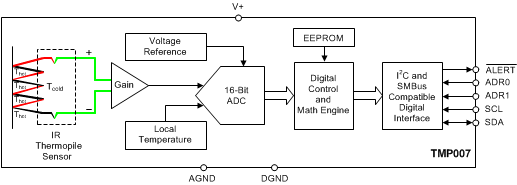ZHCSCG1C April 2014 – July 2015 TMP007
PRODUCTION DATA.
- 1 特性
- 2 应用
- 3 说明
- 4 修订历史记录
- 5 Pin Configuration and Functions
- 6 Specifications
-
7 Detailed Description
- 7.1 Overview
- 7.2 Functional Block Diagram
- 7.3
Feature Description
- 7.3.1 Spectral Responsivity
- 7.3.2 Field of View and Angular Response
- 7.3.3 Thermopile Principles and Operation
- 7.3.4 Object Temperature Calculation
- 7.3.5 Calibration
- 7.3.6 Sensor Voltage Format
- 7.3.7 Temperature Format
- 7.3.8 Serial Interface
- 7.4 Device Functional Modes
- 7.5
Register Maps
- 7.5.1 Sensor Voltage Result Register (address = 00h) [reset = 0000h]
- 7.5.2 TDIE Local Temperature Result Register (address = 01h) [reset = 0000h]
- 7.5.3 Configuration Register (address = 02h) [reset = 1440h]
- 7.5.4 TOBJ Object Temperature Result Register (address = 03h) [reset = 0000h]
- 7.5.5 Status Register (address = 04h) [reset = 0000h]
- 7.5.6 Status Mask and Enable Register (address = 05h) [reset = 0000h]
- 7.5.7 TOBJ Object Temperature High-Limit Register (address = 06h) [reset = 7FC0h]
- 7.5.8 TOBJ Object Temperature Low-Limit Register (address = 07h) [reset = 8000h]
- 7.5.9 TDIE Local Temperature High-Limit Register (address = 08h) [reset = 7FC0h]
- 7.5.10 TDIE Local Temperature Low-Limit Register (address = 09h) [reset = 8000h]
- 7.5.11
Coefficient Registers
- 7.5.11.1 S0 Coefficient Register (address = 0Ah) [reset = 260Eh]
- 7.5.11.2 A1 Coefficient Register (address = 0Bh) [reset = 0106h]
- 7.5.11.3 A2 Coefficient Register (address = 0Ch) [reset = FF9Bh]
- 7.5.11.4 B0 Coefficient Register (address = 0Dh) [reset = FF3Ah]
- 7.5.11.5 B1 Coefficient Register (address = 0Eh) [reset = FF71h]
- 7.5.11.6 B2 Coefficient Register (address = 0Fh) [reset = 0553h]
- 7.5.11.7 C2 Coefficient Register (address = 10h) [reset = 0000h]
- 7.5.11.8 TC0 Coefficient Register (address = 11h) [reset = 0034h]
- 7.5.11.9 TC1 Coefficient Register (address = 12h) [reset = 0000h]
- 7.5.12 Manufacturer ID Register (address = 1Eh) [reset = 5449h]
- 7.5.13 Device ID Register (address = 1Fh) [reset = 0078h]
- 7.5.14 Memory Access Register (address = 2Ah) [reset = 0000h]
- 8 Application and Implementation
- 9 Power-Supply Recommendations
- 10Layout
- 11器件和文档支持
- 12机械、封装和可订购信息
1 特性
2 应用
- 非接触式温度感测
- 外壳温度
- 激光打印机
- 功率继电器
- 保健与美容
- HVAC 舒适度优化
- 气体浓度
- 火焰检测
3 说明
TMP007 是一款全集成微电子机械系统 (MEMS) 热电堆传感器,无需直接接触物体即可测量其温度。热电堆会吸收物体中波长介于 4µm 至 16µm 之间(最终用户定义的视野范围)的无源红外能量。
内置数学引擎会结合热电堆的电压变化与内部冷端基准温度传感器计算目标物体温度。TMP007 还具有非易失性存储器,用于存储校准系数。
TMP007 在设计时充分考虑了可移植性和功耗要求,可轻松置于超狭窄空间内,同时采用标准表面贴装工艺。另外,该器件还具有低功耗特性,因此非常适合电池供电类 应用。
TMP006 拥有精简版功能集。TMP006 可提供与 TMP007 类似的性能,只是不包含数学引擎或非易失性存储器。
红外热电堆传感器的额定工作温度范围为 –40°C 至 +125°C。该器件可以测量超出器件工作温度范围的物体温度,前提是器件本身未超出工作温度范围(–40°C 至 +125°C)。
器件信息(1)
| 器件型号 | 封装 | 封装尺寸(标称值) |
|---|---|---|
| TMP007 | DSBGA (8) | 1.90mm x 1.90mm |
- 要了解所有可用封装,请参见数据表末尾的封装选项附录。
